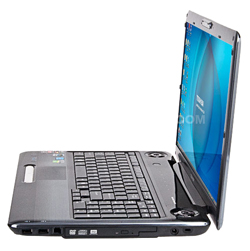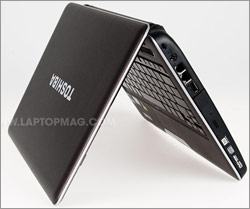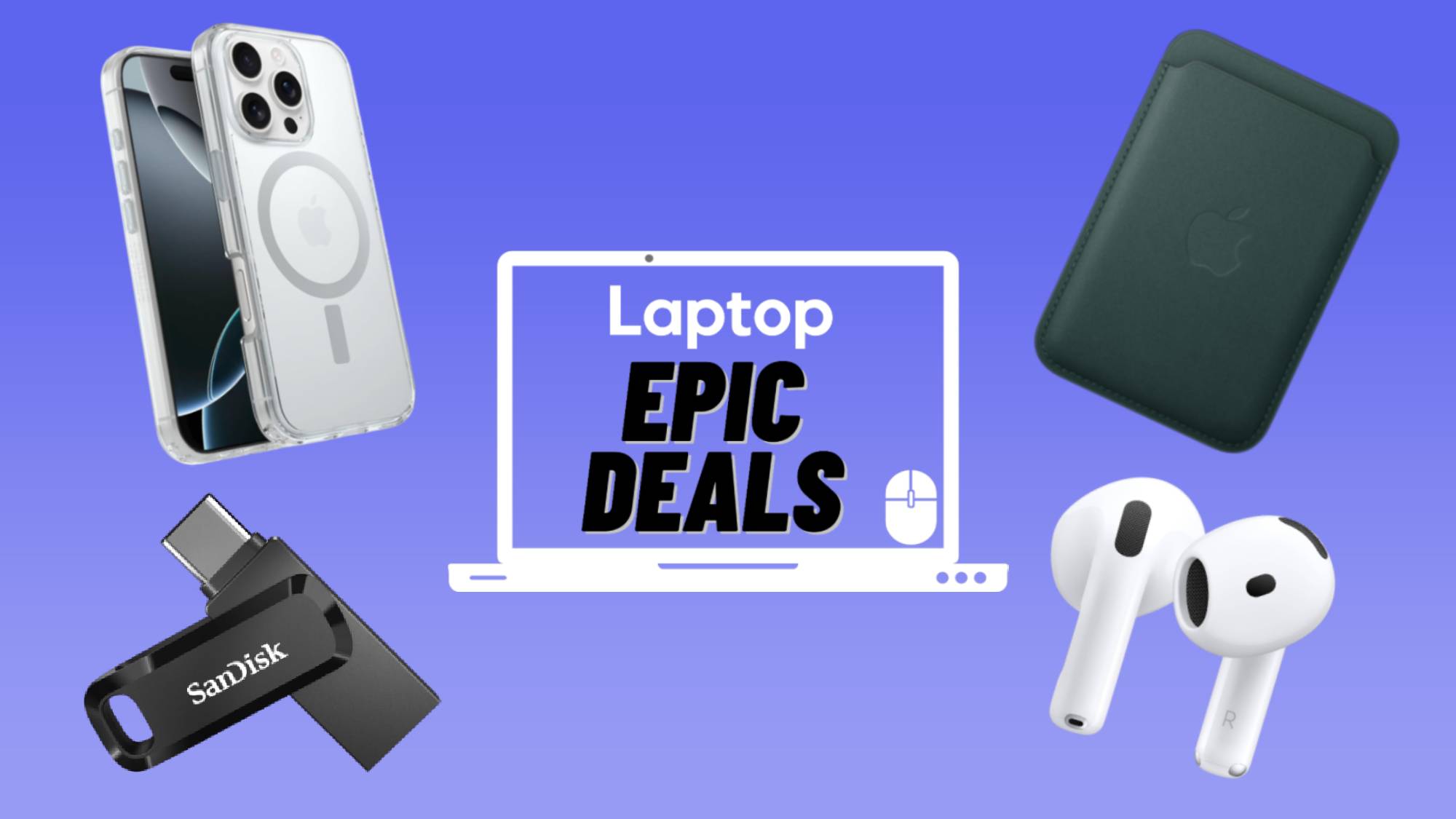Laptop Mag Verdict
This 13-inch notebook delivers a striking design and good performance for a reasonable price.
Pros
- +
Stylish dark brown design
- +
Good performance
- +
Loud speakers
- +
Comfortable keyboard
- +
Helpful Eco utility
Cons
- -
Small touchpad
- -
Webcam video a bit dark
Why you can trust Laptop Mag
With a distinctive design and plenty of convenient features, the Toshiba Satellite U505 ($799 as configured) is easily one of the best-looking 13-inch notebooks for the money. In addition to robust specs--a 2.1-GHz Core 2 Duo processor, 4GB of RAM, and 320GB hard drive--Toshiba includes convenient features, including an Eco utility that helps you save battery life and monitor energy usage, and PC health monitor software to warn against potential problems. If you can live with a small touchpad, you'll enjoy this thin-and-light machine.
Design
This is not your run-of-the-mill notebook chassis. Instead of opting for the typical glossy body, the U505 goes its own way with a unique Luxe brown textured finish on the lid and deck. (Other color options include white and pink.) Sure, it's plastic, but it feels and looks elegant compared to most other sub-$1,000 laptops. We also like the chrome accents around the keyboard, silver accents around the keyboard and lid, and the subtle backlit strip above the touchpad. The bezel of the display is a glossy black, but you won't have to whip out the polishing cloth much.
Measuring 12.5 x 9.1 x 1.5 inches and weighing 4.7 pounds, the U505 is a bit lighter but thicker than the 5-pound, 1.1-inch $999 MacBook and heavier and thicker than the $899Acer Aspire 3935(4.2 pounds, 1-inch thick). You won't want to take this machine everywhere, but it's certainly light enough for students to tote to class and move from room to room.
Keyboard and Touchpad
The U505 sports a flat keyboard whose layout leaves a good bit of room on either side of the deck. The result is that some of the keys (like the right Shift key) are slightly undersized. However, we liked the feel of the keys themselves, and that there was very little in the way of flex. Touch typists will have no problem getting acclimated to the U505.
We're not fans of the tiny touchpad on the U505, which measures 2.5 x 1.6 inches. In fact,Tosbiba's mini NB205netbook has a much larger touchpad (3.1 x 1.6 inches). Navigating the desktop was smooth, but we wish we had more room, especially since the touchpad is enabled for multi-touch gestures. Zooming in on a picture by spreading two fingers apart, for example, felt claustrophobic. On the plus side, we like the relatively large and solid touchpad buttons, and the lock button for when you want to use an external mouse.
Loud Touch-Sensitive Controls
Above the keyboard are the two speakers and a row of touch-sensitive buttons, including the Eco mode button, launch button for PowerCinema (similar to Media Center), and playback and volume controls. All of these buttons were responsive, but they emit a loud beep when pressed, which we found very annoying. The good news is that you can turn this beeping off by going into the HWSetup utility, although most users wouldn't know to do this.
Ports and Slots
The U505 stands out because its Sleep-and-Charge USB ports can charge your cell phone or other gear even when the system is powered down. Two USB ports line the left side of the notebook, one of which doubling as an eSATA port for blazing backups to external drives equipped with that port. A VGA port, HDMI port, ExpressCard slot, and mic and headphone jacks are also on the left side. The third USB port, Ethernet and modem jacks, the DVD burner, and Kensington lock slot line the right side of the U505. You'll find the memory card reader up front, along with a Wi-Fi on/off switch.

Click to enlarge

Click to enlarge
Display and Audio
The U505 features a bright and glossy 13-inch display with 1280 x 800 resolution, which means you can play 720p content. However, other 13-inch systems, such as the Acer Aspire 3935, provide even more pixels (1366 x 768). Like theL505we recently tested, the U505's drop-hinge LCD presented the clearest picture when we tilted it back a bit, and the panel kicked back distracting reflections. Otherwise, color saturation and detail were good when we streamed an episode of Mental from Hulu.com.
The two speakers above the keyboard provided plenty of volume while watching that Hulu episode and while playing a Green Day track in Slacker. We wouldn't max out the volume, however; the audio became somewhat distorted when playing music.
Webcam and Facial Recognition
It's hard to miss the webcam on the U505, which is set off from the rest of the lid with a mirrored surface, complete with the words "Web Camera" printed to the right of the lens. When we made a video call to a co-worker using Google Chat, he said we looked a little dark, which was surprising since we were sitting in an office with plenty of overhead light and ambient light from a nearby window. Sound quality was clear in both directions.
Toshiba has obviously been working on improving its facial recognition feature for logging in, because we were successful on our first attempt (even if it takes a couple minutes to set up). After logging out, we clicked Start Face Recognition and were up and running in 12 seconds.
Performance

Click to enlargeEquipped with a 2.1-GHz Intel Core 2 Duo T6500 processor and 4GB of RAM, the U505 has plenty of oomph to run Windows Vista (as well as Windows 7, should you decide to upgrade this fall). In our PCMark Vantage test, which measures application performance, this machine turned in a score of 3,187, which is nearly 200 points above average for thin-and-light notebooks. This score is also slightly above what the $1,359 13-inchSony VAIO SRturned in (3,174), a much pricier 13-inch notebook that sports a slightly slower CPU but more robust ATI discrete graphics. If you want to add an ATI Mobility Radeon H4570 graphics card to the U505, you can do so if you configure it on toshibadirect.com, if you're willing to spend an extra $80.
To test U505's multimedia prowess, we used the notebook to transcode a 5:05 MPEG-4 clip to AVI using Handbrake. The system took 7 minutes and 25 seconds, which is only slightly slower than the category average (7:12). Another 13-inch notebook in the same price range, the Aspire 3935, took 7:56. Booting into Windows Vista took 55 seconds on the U505, which is 7 seconds faster than the category average.
Hard Drive Performance
The 320GB, 5,400-rpm hard drive inside the U505, made by Hitachi, is certainly among the fastest in its class. On our LAPTOP Transfer Test, in which we copy 4.97GB folder of mixed media from one folder to another on the hard drive, the U505 turned in a data rate of 21.7 MBps. That mark is slightly lower than the Lenovo IdeaPad Y450 (23.0 MBps) but still well above the category average of 19.3 MBps. Plus, Toshiba includes a hard drive impact sensor to protect your data in case your system takes a tumble, a feature normally reserved for business notebooks.
Graphics Performance
Given that the U505 features integrated Intel GMA 4500MHD graphics, we don't recommend this laptop for gamers. All you need to do is look at the poor 6 frames per second the system turned in when playing Far Cry 2. On the other hand, the U505's 3DMark06 score of 999 isn't too shabby. It's below the category average of 1,500 but higher than budget notebooks like theHP Pavilion dv4t(776) andIdeaPad Y450(774). It took about 13 seconds to fly to our Broadway address in New York City using Google Earth, and the animation was relatively smooth.
Battery Life and Wireless Performance
Using the standard six-cell battery, the U505 lasted 3.5 hours on the LAPTOP Battery Test, which simulates continuous Web surfing over Wi-Fi. That's a decent amount of endurance, but still below the 4:13 category average (the same runtime as the Aspire 3935). If you want more runtime, spring for the larger 12-cell battery, which costs an additional $84 if you configure your notebook on Toshiba's site. Toshiba claims this battery, which attaches to the bottom of the U505 and raises it about 1 inch, will supply 7.5 to 8 hours of battery life.
We're glad the U505 features Intel's WiFi Link 5100AGN wireless card, because this notebook delivers good data rates even from a distance. We saw 21.0 Mbps of throughput from 15 feet and a still very good 19.9 Mbps from 50 feet; these numbers are both above the respective category averages of 19.5 Mbps and 15.1 Mbps.
Eco Mode and PC Health Monitor

Click to enlargeThere are two highlights to Toshiba's software bundle: the Eco Utility and PC Health Monitor. You activate the former software by pressing the Eco button above the keyboard, which looks like a little Web globe icon with a stem attached. Within this software you can monitor your power consumption (measured in watts) in real time, as well as turn Eco mode on and off. When you turn Eco Mode on, you'll see that certain system properties get changed automatically, such as the display brightness level (from 8 for High Performance to 3), and when the display and hard disk get turned off (from 5 and 10 minutes, respectively, to 3 for each). Overall power consumption in High Performance mode averaged about 28 watts, versus 18 watts in Eco Mode.
The other noteworthy utility is PC Health Monitor, which can help you keep tabs on system functions such as power consumption, battery health, and system cooling. It also tells you the system temperature (we saw 38 percent of the max when unplugged), fan speed (58 percent in our tests), and the status of the hard disk drive sensor and hard drive itself.
Other Software and Warranty
Toshiba includes a vast array of its own software, some third-party software, and trial offers of Norton Internet Security 2009 (30 days) and Microsoft Office Home and Student 2007 (60 days). Third-party apps include Google Toolbar and Picasa, Corel DVD MovieFactory, and the WildTangent Orb Game Console for playing casual games. We could do without the "special offers" for Amazon.com shopping, NetZero, Skype, and Intuit QuickBooks, but they didn't hamper performance.
Toshiba backs the U505 with a one-year standard limited warranty and 24/7 toll-free tech support.
Configuration and Upgrade Options
The $799 U505-S2930 we tested is available from a handful of retailers, including Newegg.com and Wal-Mart. You can also either build your own U500 or choose from pre-built models. The high-end U505-S2940 ($949) configuration includes a more powerful 2.0-GHz Core 2 Duo P7350 processor (which has a slower clock speed but a faster 1066-MHz bus speed) and sleek edge-to-edge glass display.
If you want to configure your own U500, there are plenty of customization options. Adding the P7350 processor adds $114, or you can spend $195 on a 2.53-GHz Core 2 Duo P8700 processor. Adding discrete graphics, the ATI Mobility Radeon H4570 GPU, adds $80. You can also increase the hard drive size up to 400GB ($46) or 500GB ($80), get a more stylish slot-loading optical drive ($29) or pick up a 12-cell battery ($84). A three-year warranty costs $85.
Upgrading the U505 on your own is a cinch. A single panel on the back of the system with three small screws stands between you and the hard drive and memory slots.
Verdict
The Toshiba Satellite U505 combines style with good performance for those on a budget. In this price range, we prefer the $899 Acer Aspire 3935, which delivers 40 minutes of extra battery life and a higher-res screen in a lighter 4.2-pound brushed metal design. Nevertheless, for $799, the U505 provides good power and portability, and Toshiba includes features that enhance the computing experience.
Toshiba Satellite U505 Specs
| Brand | Toshiba |
| CPU | 2.1-GHz Intel Core 2 Duo T6500 |
| Card Slots | 6-1 card reader, ExpressCard/34, ExpressCard |
| Company Website | http://www.toshibadirect.com |
| Display Size | 13.3 |
| Graphics Card | Intel GMA 4500MHD |
| Hard Drive Size | 320GB |
| Hard Drive Speed | 5,400rpm |
| Hard Drive Type | SATA Hard Drive |
| Native Resolution | 1280x800 |
| Operating System | MS Windows Vista Home Premium (64 bit) |
| Optical Drive | DVD /-RW |
| Optical Drive Speed | 8X |
| Ports (excluding USB) | HDMI, VGA, Ethernet, USB/eSATA, Modem, Microphone, Kensington Lock, Headphone |
| RAM | 4GB |
| RAM Upgradable to | 8GB |
| Size | 12.5 x 9.1 x 1.5 inches |
| USB Ports | 2 |
| Video Memory | 1.8GB |
| Warranty/Support | One-year standard/24/7 toll-free phone |
| Weight | 4.7 pounds |
| Wi-Fi | 802.11a/g/n |

